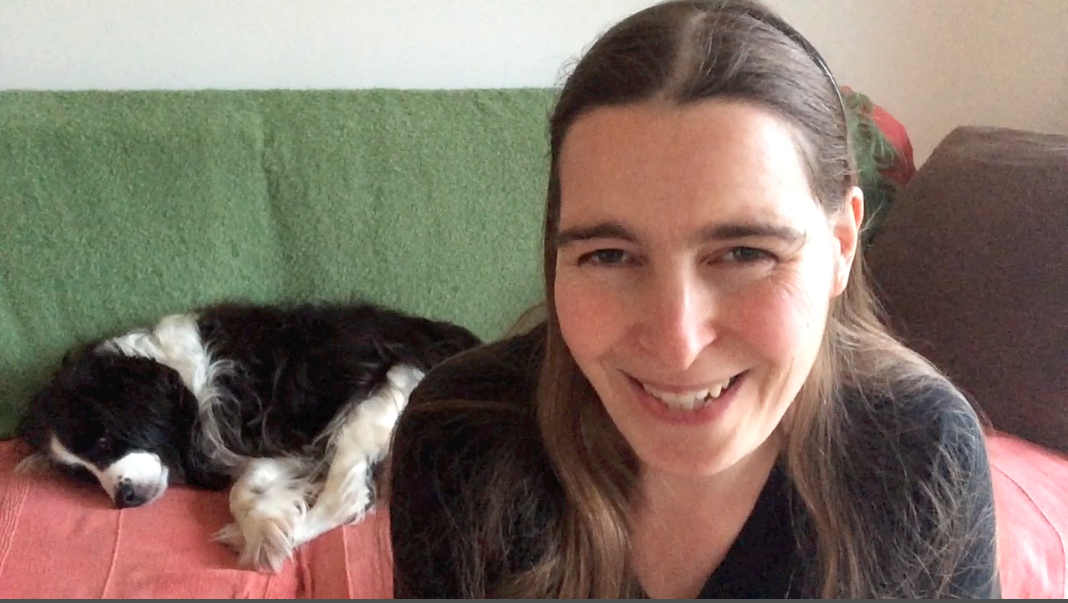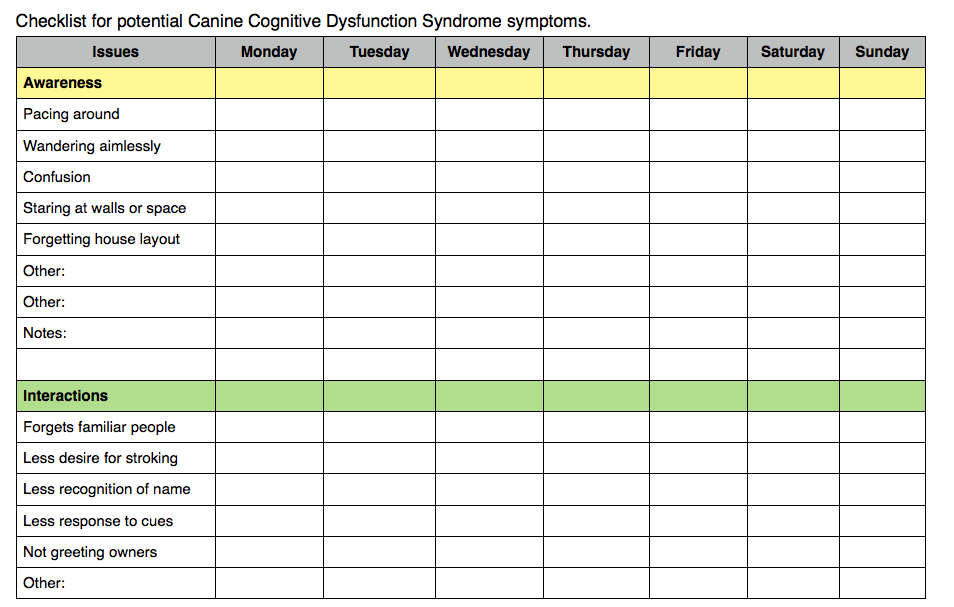 My thoughts on cognitive decline in pets (including canine cognitive dysfunction syndrome).
My thoughts on cognitive decline in pets (including canine cognitive dysfunction syndrome).
My Sally came to visit last week. She’s 17 now (and very sprightly for her age) and spends part of her time with my ex-partner and part with me. I hadn’t seen her for about a week and I was really surprised to see some obvious behavioral changes in her. Maybe I noticed them more because I don’t see her everyday or maybe they are just becoming more and more noticable.
It got me thinking about cognitive issues, especially Canine Cognitive Dysfunction Syndrome (CCDS), which is akin to Alzheimer’s in humans (it can happen to cats too). Some people reckon it’s just a fancy term for old age. CCDS can include a wide range of behavioral changes such as confusion, forgetting familliar places and people, restlessnes, aimless wandering, separation anxiety, house training issues, obsessive barking, licking, drooling, or panting. Of course, some of these symptoms can have other causes, so it’s worth checking with your vet before assuming they are caused by old age / CCDS (see below).
We see many changes as our pets age.
The symptoms above are common when pets age. With Sally last week there were three things that really stuck out for me with her behaviour.
The first is really obvious. She keeps ‘asking’ for dinner. Now, she’s always had a good appetite and is eager to eat, but usually she just waits until breakfast and dinner time and THEN gets excited (we actually have a dinner song we sing her so she knows when it’s dinner time). But now, she’ll bark and then run to her feeding area – many times a day with a really excited look on her face. She NEVER normally barks for food.
The second is that she’s more restless than before. Sometimes she won’t settle for long in one place, especially in the evening time. She’ll get up, walk around, come back, sit a while, get up, walk around and come back. She isn’t in any distress, but it’s just out of the ordinary for her.
Thirdly, she gets fussy about where I am and how close I am to her. She doesn’t like it if I sit at the computer for too long, because then she has to sit on the floor beside me or on a sofa further away from me. She will now bark in protest! She wants me beside her. I have developed a work around where I have a small table right beside a sofa, so she can sit really near me and I can still reach over and stroke her. It seeme to be a workable compromise for now.
These changes can be hard to take.
I’ll admit that I was quite taken aback by all this and it took me a day to actually start using my tools and techniques to make a difference. It’s incredibly disconcerting to see our beloved pets change in these ways. Also, at times when I look at her, it’s like she’s ‘not there’. I’ve seen it time and time again in elderly dogs. Those moments when it feels like their spirit is elsewhere.
Mostly, she’s still playful and happy and content, often lying there half asleep in belly rub pose (on her back, belly up) but, it can be hard in those moments when she’s ‘not her ususal self’.
When our elderly pets seem to be in cognitive decline it reminds us that they may not be around forever and that nothing stays the same. It may bring up some strong emotions to be dealt with as we come to terms with their mortality and wonder how to best help them through the changes they are going through.
What to do if your elderly dog (or cat) starts to act differently?
1. Go to the veterinary consultant: As I said earlier, there can be many causes for the different symptoms that match those of CDS, for example thyroid or kidney issues among others, so it’s best to get your pet checked out in case there are some easily treatable issues which can make their life more comfortable or to rule out (or become aware of) the onset of a disease that you can provide treatment for.
They may also be able to recommend appropriate dietary regimes, medication or supplements to enhance cognitive function in your dog.
2. Keep their lives interesting and fun: It is commonly said that keeping their mind and body active helps retain cognitive function and vitality in pets. So, keep walking your dog (appropriately for their age and physical health), give them puzzle treats (toys that release treats when actively played with) if appropriate, play games with your cat or dog and give them a stimulating indoor environment too. The more active and interesting their life is, the better.
3. Try positive re-inforcement: You can use positive re-inforcement training techniques to consistently reward your pet for good behaviour, which could help them to unlearn any ‘bad habits’ as you remind them of what desired behaviour you want from them. On the other hand, be aware that if you go over and pay attention to them when they are barking or performing an ‘unwanted’ behaviour, it can re-inforce that behaviour as they get attention for it. Patience and persistence are key here. It may be advisable to also get professional help.
If you have successfully used training techniques in the past, such as clicker training with rewards, then try it for the behaviours that need adjustment now. For house training issues, it can be worth going through toilet training techniques again (if the issue is related to other conditions such training may not be effective).
4. Make a note of their changes in behaviour and happiness levels: This makes it easier to track changes over time, assess their quality of life and it’s good information to have when talking to veterinary consultants. If you have a notebook and use it daily to record their eating habits, mood, activity levels and behaviour (especially any out of the ordinary) you will build up a good picture of their overall health and well-being.
Here is a checklist that I have made for you to download so you can track your pet’s behaviour on a weekly basis. Right click on the link below to download the checklist.
CCDS weekly checklist by Ferris Jay
5. Look at your own emotional responses to their changes: Their changes can be hard for us to deal with, as I mentioned earlier. Seeing strange behaviour and a derioration in their cognitive function can bring up our fears of their mortality. It can be hard to deal calmly with changes that may be disruptive or frustrating, for example compulsive barking, pacing or agression.
Later I show how I used a technique called EFT tapping to deal with my upset and frustration around Sally’s recent behaviour. If you haven’t heard of EFT tapping before, click here for an introduction to EFT tapping techniques). other techniques, such as meditation may also be helpful. If you find it hard to deal with your emotions and reactions, their are specialists, such as myself who can help you.
6. Be thoughtful and considerate to their needs / limitations: Elderly pets can become slightly less tolerant of unfamilliar situations, people and other animals. So, be considerate of that when going on trips or having events at your home. E.g. even though they may once have loved playing with children, be prepared for the possibility that their tolerance levels may have changed and give them the opportunity to have quiet space if they seem to be uncomfortable in different company.
Sally used to love going to historical events we were performing at, but 2 years ago it became obvious that she wasn’t enjoying them anymore, so we made alternative arrangements for her.
7. Use complementary and holistic techniques: As an energy therapist I know the power of energy work and I encourage people to gentle techniques, such as EFT tapping, for their pets. Hands on healing, such as reiki also work well. Below, I share how I used the tapping to help both Sally and myself last week.
Please remember that all holistic and energy treatments should be complementary to veterinary care and not a substitute for it.
I ensure that all my animal clients are also under the supervision of a vet.
How I helped myself and Sally using EFT tapping
After getting over my initial surprise about her changing behaviour on the first day of Sally’s visit I went straight for the EFT tapping on day 2.
Firstly I tapped for my own emotional reaction to the changes I was experiences. For example, I could feel the tension every time I felt she was going to bark. So I tapped on that. Then I tapped for her, a soothing conversational style of tapping, to help her know that everything was ok. Being an energy healer, I also sent her energy and love.
The tapping worked really well, and when she left several days later, she was no longer barking for food and less likely to ‘protest’ when I sat at the computer. She still wandered a bit in the evenings, but that was something she had done a little before anyway. I was also much calmer and more relaxed (I had got a bit frustrated with the barking at first – and then guilty at being frustrated with Sally – but the tapping cleared all that and I felt huge relief).
In today’s video I share my experience of using EFT tapping with Sally last week, highlighting 2 different ways of tapping. If you are new to tapping for yourself and your pet, I hightly recommend signing up for my free video series, which walks you through different ways of tapping for your pet’s issues.
That being said, tapping is so easy that you could just tap along with the video and get great results (just be sure to focus on your your issue and your pet even though you tap along to my words and by a process called borrowing benefits, it will work for you).
Click here or on the image below to watch the video.
Have your say.
I love to hear your thoughts about CCDS. Also, have you got stories of how you helped your pet stay mentally alert in old age?
If you’ve tapped along with the video, see how you felt afterwards and let me know what shifts occurred for you and your pets.
Just leave your comment below.
Also, feel free to share this post and video with anyone you know who will benefit from it.
Thank you.



Very interesting approach, Ferris, thank you so much for this (and the EFT tips)!
You’re very welcome Llyane.
[…] (Canine Cognitive Dysfunction Syndrome) I used the tapping to first calm myself and then her (see this post for details). Her symptoms quickly dissipated. I also have a free video series demonstrating how […]